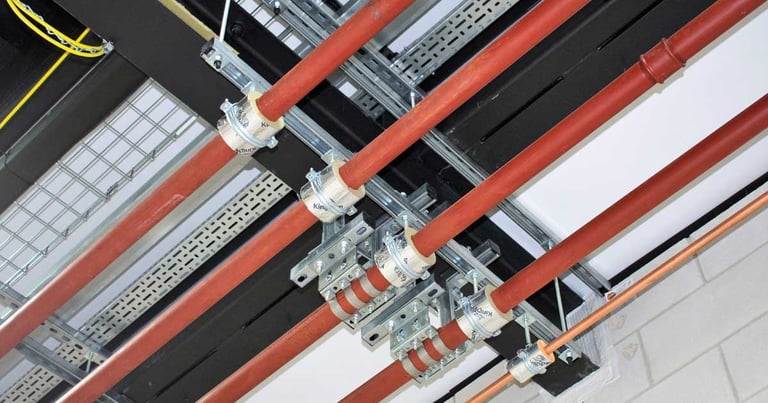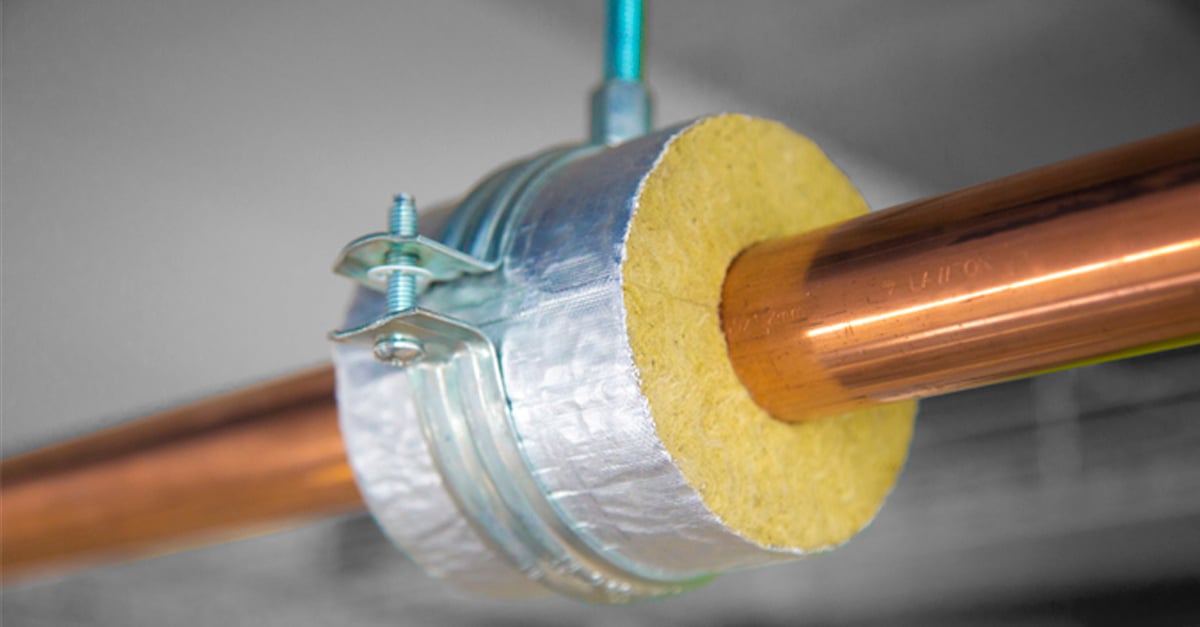Pipe insulation blocks are an area of M&E which has plenty of guidance and standards around, but not many actually follow them. Though there’s plenty of information out there, this can actually make it more confusing than it needs to be. Our aim is to eliminate this confusion as much as possible and help you approach the guidance in the simplest way, to arrive at the best possible option for your installation. As you probably know, there is a growing desire within the sector for a more responsible and sustainable future. You reading this article means you’re taking the first step to learn more about pipe insulation blocks and follow best practices in relation to them – so well done! Navigate through the following subheadings and keep reading:
- What are pipe insulation blocks?
- Why do you need pipe insulation blocks?
- What do you need to know before specifying pipe insulation blocks?
- Are hardwood pipe insulation blocks banned under BS5970?
- What is a phenolic pipe insulation block?
- Why would you specify a phenolic pipe insulation block?
- What is a mineral wool pipe insulation block?
- Why would you specify a mineral wool pipe insulation block?
- What are BS5970 and CIBSE CP1 Code of practice and how will they influence my selection?
- Conclusion
What are pipe insulation blocks?
Pipe insulation blocks, also called insulated pipe supports, are blocks of insulation fitted onto pipework and clamped into place. There are three main types of pipe insulation blocks: phenolic foam, hardwood, and mineral wool.
Why do you need pipe insulation blocks?
The purpose of insulated pipe supports is to isolate the pipework from the pipe clamp and therefore mitigate heat loss and thermal bridging within pipework systems. They also have load-bearing capabilities and provide a vapor barrier against moisture.
A lot can go wrong if pipes are poorly insulated. For example, in freezing temperatures, standing water in pipes can freeze and expand, causing cracks that may break open or burst completely. Moreover, lack of insulation causes water condensation which can speed up the process of deteriorating pipes, causing erosion, and further leaks and cracks.
So, you should always specify the correct product for the application. Though standard pipe insulation meets the thermal performance requirements, it doesn't meet the load-bearing requirements. Similarly, while a hardwood pipe insulation block could meet the load-bearing requirements, it doesn't meet thermal performance requirements. This leads us to our next point...
What do you need to know before specifying pipe insulation blocks?
As an M&E contractor, you should think about the following when specifying pipe insulation blocks:
- Does it comply with BS5970 and the insulation specification?
- What is the insulation system?
- What is the size of the pipe?
- Is the pipe you will be placing the block around made of copper or steel?
- How does the pipe insulation block react to fire? (UKCA marking & Euroclass fire certification)
- How does it react to compressive strength?
- What’s the environment surrounding it?
- Is it outdoors? If so, ensure it’s clad with suitable weatherproof material that matches the insulation specification.
Are hardwood pipe insulation blocks banned under BS 5970?
These are used along with pipe saddles/clamps to ensure that the pipe insulation does not compress at each support location.
And while these are an option, they’re often the last resort compared to the other two as they are not thermally efficient due to being made out of wood. In fact, the BS5790 states that wood blocks should not be specified where load-bearing insulation is required for pipes operating above or below ambient temperatures. So, while they’re not technically banned in the true sense of the word, there isn’t really an instance where you should use them.

What is a phenolic pipe insulation block?
Phenolic pipe insulation blocks are pipe supports manufactured from load-bearing phenolic foam to prevent heat loss or gain through pipe supports, condensation, and corrosion issues when supporting temperature-controlled water pipes.
These can be specified on Low Temperature, Hot Water (LTHW) as well as Chilled Water Systems (CHW) pipework – anywhere between -50°C and 110°C. Usually, they’re selected for internal environments rather than external ones.
Why would you specify a phenolic pipe insulation block?
Because they have lower thermal conductivity, they can restrict heat loss and gain effectively and therefore are a reliable option.
For heat networks, most of the time phenolic pipe insulation blocks are specified over other types of insulation blocks, because they can handle the temperature of an LTHW system and would be in compliance with the BS EN ISO 10211: 2007 code of practice. This would help protect against overheating, particularly in areas such as common corridors.
Phenolic block holds a fire classification of BL-S1, d0, which means it is made of combustible material. This makes it less favourable to mineral wool blocks. Speaking of which...

What is a mineral wool pipe insulation block?
These blocks are made from mineral wool, which is made from basalt rock (dark igneous rock formed from the rapid cooling of molten lava), clag, coke (grey hard porous fuel) and recycled stone wool waste.
Mineral wool blocks can be used for most temperatures in pipework, including LTHW, CHW, medium and very hot pipework. The only exception is sub-zero applications which this type of pipe block is not suitable for.
Why would you specify a mineral wool pipe insulation block?
They are more thermally efficient than hardwood blocks but less efficient than phenolic blocks. In many cases, Rockwool pipe supports are specified as a specific component of a Rockwool system.
In terms of how it reacts to fire, the standard Rockwool ROCKLAP product is A2 rated, which means it has limited combustibility, and would produce little or no smoke and no droplets. The stone/mineral wool can withstand temperatures between 0 and 250°C.

What are BS 5970 and CIBSE CP1 Code of practice and how will they influence my selection?
There are two main documents that are there to guide you in the selection process and teach you the best practices with pipe insulation blocks. These are the BS 5970 and the CP1 Code of Practice.
The BS 5970 is the British Standard for the thermal insulation of pipework, ductwork, associated equipment, and other industrial installations in the temperature range of -100°C to +870°C
It mentions the ‘preferred pipe support’ option which, for both above and below ambient applications, is to have a “hanger incorporating load-bearing insulation”. There is also a non-preferred option for above ambient applications, but this involves a further layer of insulation around the pipe support junction and up the threaded rod.
As previously mentioned, the standard outlines that wood blocks should not be specified or used in almost all cases because of their poor insulation properties.
In terms of good practice, contractors should seek guidance from the insulation manufacturer for pipe support applications when dealing with pipes larger than 200mm NB. This is particularly important in plant room situations where there may be an increased presence of additional pipework equipment (e.g. valves), thus increasing the loading. In cases like these, wood blocks should only be used when it can be proven that the insulation manufacturer alternative cannot be engineered to meet the load requirements.
The BS5970 also states that the M&E contractor should consider installation factors, including:
- Pipe insulation blocks should have a pipe bracket around them.
- Pipe support blocks should match the thickness of the insulation on the pipe system.
- Pipework may need to be bracketed more regularly and load bearing pipe supports may need to be specifically manufactured at longer lengths or increased densities if the pipe sizes are above 200mm.
The CIBSE CP1 Code of Practice was published in January 2021 and established minimum standards to improve the quality of district heating projects, and heat networks.
It stated that the minimum pipe insulation thickness should be 50mm - bearing this in mind, you need to ensure that the pipe insulation block specified is large enough to accommodate.
It also states a targeted heat loss of 100W/dwelling. To achieve this, you will likely have to exceed the 50mm block thickness minimum.
It’s important to note that early engagement between the M&E contractor and the thermal contractor will help achieve the optimal result when specifying and sourcing the right type and size of pipe support, as well as to ensure compliance.
Conclusion
Pipe support insulation blocks should not be overlooked. They’re essential for continuity of the vapour barrier on below ambient applications, mitigating heat loss, and reducing overheating issues. Hopefully, this article has given you a clearer picture of the purpose of pipe supports, the importance of selecting the correct type and size, and all the factors that should be considered.
It comes down to the suitability of the pipe insulation block for a given environment, abiding with the latest codes of practice, and engaging with a thermal contractor and the supply chain to ensure both the pipework insulation and the insulation blocks match up to optimise the thermal efficiency of the pipework system.
References
- Çavuş, V., Şahin, S., Esteves, B., and Ayata, U. (2019). "Determination of thermal conductivity properties in some wood species obtained from Turkey," BioRes. 14(3), 6709-6715. Available at:
https://bioresources.cnr.ncsu.edu/resources/determination-of-thermal-conductivity-properties-in-some-wood-species-obtained-from-turkey/ - Davison, C., 2020. Specifying pipe supports - thermal performance. Kingspan. Available at: https://www.kingspan.com/gb/en-gb/products/technical-insulation/knowledge-base/articles-and-advice/specifying-pipe-supports-thermal-performance
- Horizon Services, (2010). THE IMPORTANCE OF PIPE INSULATION. Available at: https://www.horizonservices.com/about-us/blog/the-importance-of-pipe-insulation
- Peroni, (2013). EN Reaction to Fire Classification. Available at: https://www.peroni.com/lang_UK/_download/EN_Reaction_to_Fire_Classification.pdf
- Walraven UK, (2019). An overview of insulated pipe supports. Available at: https://www.walraven.com/en/about-walraven/news/insulated-pipe-supports/#:~:text=What%20are%20insulated%20pipe%20supports,an%20increase%20in%20energy%20usage


